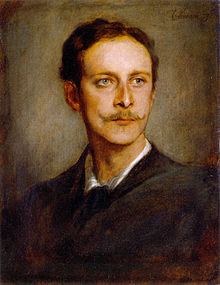Fritz von Harck

Fritz von Harck , actually Ludwig Friedrich von Harck, (born April 29, 1855 in Leipzig ; † March 26, 1917 ibid) was a German art historian, art collector and patron.
Life
Fritz von Harck was the son of the Leipzig merchant, city councilor and art collector Julius Harck . After completing his school education, he began an apprenticeship with a Hamburg overseas trader before he found a job in the Berlin bank Frege & Co. in 1875 . In 1877 he gave up this activity due to his personal inclinations in favor of a traineeship at the Berlin Kupferstichkabinett .
He followed this activity by studying art history in Vienna and Munich. With Johann Rudolf Rahn and Anton Salomon Vögelin (1804–1880) in Zurich he received his doctorate. phil. In 1887 he married Helene Schnitzler. He went on a world tour and visited Italy regularly.
From 1880 he was co-owner of the Seusslitz baroque palace, which already belonged to his parents . From 1908 he settled in his parents' house at Karl-Tauchnitz-Straße 6 in Leipzig.
Art collector
Fritz von Harck began to build up his own art collection from around 1880. He was particularly fond of the German and Italian Renaissance , the decorative arts of the 18th century and Asian art. Among the most important paintings in his possession were works by Amadeo da Pistoia ( Mary with the Child ), Fra Angelico ( Johannes d. T. ), Amico Aspertini ( St. Sebastian ), Hans Baldung ( The Seven Ages of Woman ), Leandro Bassano ( lute player ), Lodovico Carracci ( St. Sebastian ), Cima da Conegliano ( Madonna head ), Dosso Dossi ( The Resurrection of Christ ), Francesco Guardi ( Venetian vedute ), Liberale da Verona ( adoring Mary, the Child ) and Giovanni Battista Tiepolo ( St. Roch ). He was a close friend of the art historian Wilhelm von Bode , whom he accompanied to Italy several times. Harck was instrumental in founding the Leipzig Museum of Applied Arts . He also worked for the Harmonie Society (Leipzig) .
Fritz von Harck was a founding member of the Kaiser Friedrich Museum Association and the Royal Society in Berlin as well as the Harmonie Society and the "Society of Friends of the Museum of Applied Arts in Leipzig" in Leipzig.
He bequeathed his extensive art collection to the Museum of Fine Arts and the Museum of Applied Arts in Leipzig.
Honors
A green area in the northeast corner of the Musikviertel was named after Fritz von Harck in Leipzig in 1917 , which was created at the end of the 19th century after the Nonnenmühle was demolished and the Karl-Tauchnitz Bridge was built and in 1999/2000 in connection with the The re-exposure of the Pleißemühlgraben was fundamentally redesigned.
literature
- Sven Kuhrau: The art collector in the empire. Art and representation in Berlin's private collector culture. Ludwig, Kiel 2005, ISBN 3-937719-20-2 .
- Horst Riedel: Stadtlexikon Leipzig from A to Z. Pro Leipzig, Leipzig 2005, ISBN 3-936508-03-8 , p. 217
Individual evidence
- ^ Fritz-von-Harck-Anlage in the Leipzig-Lexikon
| personal data | |
|---|---|
| SURNAME | Harck, Fritz von |
| BRIEF DESCRIPTION | German art historian, art collector and patron |
| DATE OF BIRTH | April 29, 1855 |
| PLACE OF BIRTH | Leipzig |
| DATE OF DEATH | March 26, 1917 |
| Place of death | Leipzig |